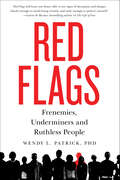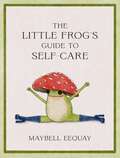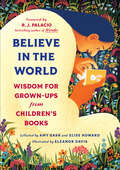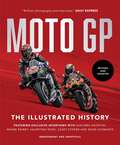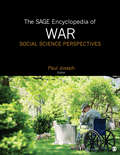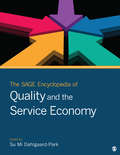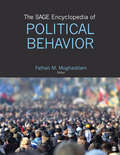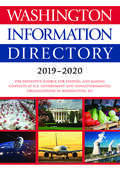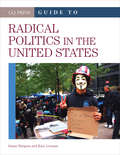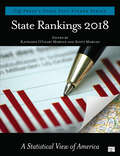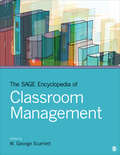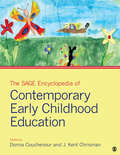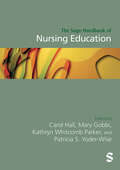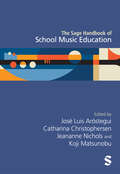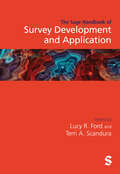- Table View
- List View
Red Flags: Frenemies, Underminers and Ruthless People
by Wendy L. PatrickWe all need emotional blinders: the etiquette that keeps society smoothly moving depends on it. But when you absolutely must rely on another person, you have to be able to assess them objectively. In RED FLAGS, author Wendy L. Patrick shares simple strategies anyone can use to spot deceptive or downright dangerous people who use ingratiation and social convention to draw in and lull victims.Readers will learn how even the most skeptical of us use rose-colored lenses on those around us, in three sections:-Blinded by Desire-from the alluring lenses of attraction and positive attention to the blindness of marital "bliss" and the distorted lens of delusion-Overlooking Red Flags in a Professional Setting-how reassuring proximity and the false security of credibility and similarity can lead to costly mistakes -Be Afraid of What You Can't See-the ultimate cost of wearing emotional blinders around the truly disturbed/criminal, from sexual predation to domestic abuse, stalking and cyberstalking. Readers will learn how to:-avoid selective attention-observe people over time (bad guys rely on first impressions)-ask questions: most people's favorite topic is themselves-cybersleuth to verify information and track down inconsistenciesYou need this book if you:-want to know if a potential boyfriend is trustworthy-are interviewing or hiring new employees-are selecting anyone to take care of your children-are lending money or property-have partners in business
The Little Frog's Guide to Self-Care: Affirmations, Self-Love and Life Lessons According to the Internet's Beloved Mushroom Frog
by Maybell EequayHop into this uplifting little book, filled with positive affirmations on self-love and empowerment, as told by the internet's beloved mushroom frog "Don't forget about the subtle magic that is happening all around you every day" Meet the little frog! With its mushroom cap and endless collection of fabulous footwear, this adorable amphibian is here to be your new best friend. Whether you need an emotional boost, some friendly encouragement or an honest view on the world, the little frog will be your guide. Created by the California-based artist Maybell Eequay, this book is a perfect compassionate gift for yourself or others. Inside you will find:- Over 40 hand-drawn illustrations of the little frog- Beautiful life lessons and empowering reminders that it's okay to be gentle with yourself and to feel your feelings- A humorous, no-nonsense approach to positivityThese illustrations will fill your heart with love for yourself and others, and remind you that it's brave and wonderful of you to exist!
Believe In the World: Wisdom for Grown-Ups from Children's Books
by Amy Gash Elise HowardAn inspiring and delightful illustrated collection of quotations from a diverse range of our most beloved children's books that will help teach all of us how to live in the world today, perfect for gift season and for readers of books like The Boy, The Mole, The Fox, and The Horse and How to Love the World. Everything we need to know as adults can be found in the brilliant, imaginative, diverse world of children's books. That is the simple yet powerful promise that Believe In the World offers. This illustrated, gifty collection, with witty and inspirational quotations organized in chapters such as "How to Believe in the World" and "How to Have Fun in the World," reminds us not to lose sight of the values we learned as kids—to be courageous, to do good deeds, to respect our imaginations, and maybe even to break a few rules every once in a while. Some quotations will bring readers back to old favorites like The Little Prince or Ramona Forever while others will lead to new discoveries inspired by the exciting new variety of children&’s books being published today. And all provide a roadmap to doing and being good in the world. As one reviewer wrote about Believe In the World's predecessor, What the Dormouse Said, published by Algonquin in 1999, &“Whether you&’re looking for wisdom about goodness or sadness or even more practical matters, you will surely find it in this delightful collection.&”Believe In the World lands in the sweet spot of nostalgic and entertaining; fresh and enlightening. And at the same time, it reminds us of the exhilaration of being a reader, young at heart, venturing forth into the world of storybooks and unforgettable characters and confirming that we are never too old to recapture the lessons, pleasures, and exuberance of childhood.
MotoGP: The Illustrated History 2023
by Michael ScottThe daring exploits of motorcycle race legends Valentino Rossi, Barry Sheene, Casey Stoner and John Surtees are all gloriously celebrated in MotoGP: The Illustrated History.Updated and packed with more than 150 stunning photographs, this authoritative and long-overdue illustrated history celebrates high performance motorbike racing since the start of the world championship in 1949.Each racing decade is dissected and discussed, as are the big incidents, top personalities and technological innovations. To complete the book, motorcycle racing's greatest names - including John Surtees, Giacomo Agostini, Kenny Roberts, Valentino Rossi, Casey Stoner and Marc Marquez - provide exclusive personal insights and accounts of what it is like to race at speeds of 200mph. MotoGP: The Illustrated History is a unique book which brilliantly conveys the exhilarating spirit of this stunning sport.
MotoGP: The Illustrated History 2023
by Michael ScottThe daring exploits of motorcycle race legends Valentino Rossi, Barry Sheene, Casey Stoner and John Surtees are all gloriously celebrated in MotoGP: The Illustrated History.Updated and packed with more than 150 stunning photographs, this authoritative and long-overdue illustrated history celebrates high performance motorbike racing since the start of the world championship in 1949.Each racing decade is dissected and discussed, as are the big incidents, top personalities and technological innovations. To complete the book, motorcycle racing's greatest names - including John Surtees, Giacomo Agostini, Kenny Roberts, Valentino Rossi, Casey Stoner and Marc Marquez - provide exclusive personal insights and accounts of what it is like to race at speeds of 200mph. MotoGP: The Illustrated History is a unique book which brilliantly conveys the exhilarating spirit of this stunning sport.
A Companion to Applied Philosophy of AI (Blackwell Companions to Philosophy)
by Martin Hähnel Regina MüllerA comprehensive guide to AI's ethical, epistemological, and legal impacts through applied philosophy Inartificial intelligence (AI) influences nearly every aspect of society. A Companion to Applied Philosophy of AI provides a critical philosophical framework for understanding and addressing its complexities. Edited by Martin Hähnel and Regina Müller, this volume explores AI's practical implications in epistemology, ethics, politics, and law. Moving beyond a narrow ethical perspective, the authors advocate for a multi-faceted approach that synthesizes diverse disciplines and perspectives, offering readers a nuanced and integrative understanding of AI's transformative role. The Companion explores a broad range of topics, from issues of transparency and expertise in AI-driven systems to discussions of ethical theories and their relevance to AI, such as consequentialism, deontology, and virtue ethics. Filling a significant gap in the current academic literature, this groundbreaking volume also addresses AI's broader social, political, and legal dimensions, equipping readers with practical frameworks to navigate this rapidly evolving field. Offering fresh and invaluable insights into the interplay between philosophical thought and technological innovation, A Companion to Applied Philosophy of AI: Features contributions from leading philosophers and interdisciplinary experts Offers a unique applied philosophy perspective on artificial intelligence Covers diverse topics including ethics, epistemology, politics, and law Encourages interdisciplinary dialogue to better understand AI's profound implications for humanity A Companion to Applied Philosophy of AI is ideal for undergraduate and graduate courses in applied philosophy, AI ethics, political theory, and legal philosophy. It is also a vital reference for those working in areas including AI policy, governance, and interdisciplinary research.
The SAGE Encyclopedia of War: Social Science Perspectives
by Paul JosephTraditional explorations of war look through the lens of history and military science, focusing on big events, big battles, and big generals. By contrast, The SAGE Encyclopedia of War: Social Science Perspective views war through the lens of the social sciences, looking at the causes, processes and effects of war and drawing from a vast group of fields such as communication and mass media, economics, political science and law, psychology and sociology. Key features include: More than 650 entries organized in an A-to-Z format, authored and signed by key academics in the field Entries conclude with cross-references and further readings, aiding the researcher further in their research journeys An alternative Reader’s Guide table of contents groups articles by disciplinary areas and by broad themes A helpful Resource Guide directing researchers to classic books, journals and electronic resources for more in-depth study This important and distinctive work will be a key reference for all researchers in the fields of political science, international relations and sociology.
The SAGE Encyclopedia of War: Social Science Perspectives
by Paul JosephTraditional explorations of war look through the lens of history and military science, focusing on big events, big battles, and big generals. By contrast, The SAGE Encyclopedia of War: Social Science Perspective views war through the lens of the social sciences, looking at the causes, processes and effects of war and drawing from a vast group of fields such as communication and mass media, economics, political science and law, psychology and sociology. Key features include: More than 650 entries organized in an A-to-Z format, authored and signed by key academics in the field Entries conclude with cross-references and further readings, aiding the researcher further in their research journeys An alternative Reader’s Guide table of contents groups articles by disciplinary areas and by broad themes A helpful Resource Guide directing researchers to classic books, journals and electronic resources for more in-depth study This important and distinctive work will be a key reference for all researchers in the fields of political science, international relations and sociology.
The SAGE Encyclopedia of Quality and the Service Economy
by Su Mi Dahlgaard-ParkSociety, globally, has entered into what might be called the "service economy." Services now constitute the largest share of GDP in most countries and provide the major source of employment in both developed and developing countries. Services permeate all aspects of peoples’ lives and are becoming inseparable from most aspects of economic activity. "Quality management" has been a dominating managerial practice since World War II. With quality management initially associated with manufacturing industries, one might assume the relevance of quality management might decrease with the emergence of the service economy. To the contrary, the emergence of the service economy strengthened the importance of quality issues, which no longer are associated only with manufacturing industries but are increasingly applied in all service sectors, as well. Today, we talk not only about product or service quality but have even expanded the framework of quality to quality of life and quality of environment. Thus, quality and services have emerged in parallel as closely interrelated fields. The Encyclopedia of Quality and the Service Economy explores such relevant questions as: What are the characteristics, nature, and definitions of quality and services? How do we define quality of products, quality of services, or quality of life? How are services distinguished from goods? How do we measure various aspects of quality and services? How can products and service quality be managed most effectively and efficiently? What is the role of customers in creation of values? These questions and more are explored within the pages of this two-volume, A-to-Z reference work.
The SAGE Encyclopedia of Political Behavior
by Fathali M. MoghaddamThe SAGE Encyclopedia of Political Behavior explores the intersection of psychology, political science, sociology, communications, and human behavior to better understand why and how people interact with political processes. Bringing together scholars from around the world, the encyclopedia integrates theories, research, and case studies from a variety of disciplines to help readers better understand the complexities of political behavior. Contributors analyze the forces that shape the behavior of individuals, groups, and social movements and how that behavior impacts political outcomes and public policy debates. In over 360 entries, the encyclopedia focuses broadly on the following topics: Cognitive processes Group identities and influence Individual political behavior International/comparative perspectives Justice and political behavior Media, discourse, and communications Policies and political behavior Political systems Security and terrorism Social political movements Theories of political behavior Voting behavior and political campaigns Aimed at college and university students, this one-of-a-kind reference covers voting patterns, interactions between groups, what makes different types of government systems appealing to different societies, and the impact of early childhood development on political beliefs, among others. Topics explored by political psychologists are of great interest in fields beyond either psychology or political science, with implications, for instance, within business and management. This title will be available online on SAGE Knowledge, the ultimate social sciences library.
Washington Information Directory 2019-2020
by Cq PressThe Washington Information Directory is the essential one-stop source for information on U.S. governmental and nongovernmental agencies and organizations. This thoroughly researched guide provides capsule descriptions that help users quickly and easily find the right person at the right organization. The Washington Information Directory offers three easy ways to find information: by name, by organization, and through detailed subject indexes. Although it is a "directory, the volume is topically organized, and within the taxonomic structure the relevant organizations are listed not only with contact information but with a brief paragraph describing what the organization (whether government or nongovernmental) does related to that topic. It is focused on Washington—in order to be listed, an organization must have an office in the Washington metropolitan area. These descriptions are not boilerplate advertising material from the organizations; rather, they are hand-crafted by a talented freelance research team. In addition, the Washington Information Directory pulls together 55 organization charts for federal agencies, congressional resources related to each chapter topic, hotline and contact information for various specific areas of interest (from Food Safety Resources to internships in Washington), and an extensive list of active congressional caucuses and contact details. It has two appendices, one with thorough information on congresspersons and committees, and the second with governors and embassies. With more than 10,000 listing and coverage of the new presidential administration, the 2019–2020 Edition features contact information for the following: • 116th Congress and federal agencies • Nongovernmental organizations • Policy groups, foundations, and institutions • Governors and other state officials • U.S. ambassadors and foreign diplomats • Congressional caucuses
CQ Press Guide to Radical Politics in the United States
by Susan R. Burgess Kathryn C. LeemanThe CQ Press Guide to Radical Politics in the United States is a unique work which provides an overview of radical U.S. political movements on both the left and the right sides of the ideological spectrum. It focuses on analyzing the origins and trajectory of the various movements, and the impact that movement ideas and activities have had on mainstream American politics. This guide is organized thematically, with each chapter focusing on a prominent arena of radical activism in the United States. These chapters will: Trace the chronological development of these extreme leftist and rightist movements throughout U.S. history Include a discussion of central individuals, organizations, and events, as well as their impact on popular opinion, political discourse, and public policy Include sidebar features to provide additional contextual information to facilitate increased understanding of the topic Seeking to provide an accessible, balanced, and well-documented discussion of topics often overlooked in political science, this book includes an introduction to anarchism, communism, and socialism as well as the Chicano movement, civilian border patrols, Black power, the Ku Klux Klan, ACT-UP, the militia movement, Occupy Wall Street, farmers’ rebellions, Earth First!, the Animal Environmental Liberation Front, and many others.
The SAGE Encyclopedia of Political Behavior
by Fathali M. MoghaddamThe SAGE Encyclopedia of Political Behavior explores the intersection of psychology, political science, sociology, communications, and human behavior to better understand why and how people interact with political processes. Bringing together scholars from around the world, the encyclopedia integrates theories, research, and case studies from a variety of disciplines to help readers better understand the complexities of political behavior. Contributors analyze the forces that shape the behavior of individuals, groups, and social movements and how that behavior impacts political outcomes and public policy debates. In over 360 entries, the encyclopedia focuses broadly on the following topics: Cognitive processes Group identities and influence Individual political behavior International/comparative perspectives Justice and political behavior Media, discourse, and communications Policies and political behavior Political systems Security and terrorism Social political movements Theories of political behavior Voting behavior and political campaigns Aimed at college and university students, this one-of-a-kind reference covers voting patterns, interactions between groups, what makes different types of government systems appealing to different societies, and the impact of early childhood development on political beliefs, among others. Topics explored by political psychologists are of great interest in fields beyond either psychology or political science, with implications, for instance, within business and management. This title will be available online on SAGE Knowledge, the ultimate social sciences library.
State Rankings 2018: A Statistical View of America
by Scott Morgan Kathleen O’Leary MorganPublished annually, State Rankings features comprehensive state statistics across key measures in education, health, crime, transportation, taxes, government finance, and so much more. The editors compile useful statistics that otherwise take an enormous amount of time to research, making it a favorite resource on reference shelves throughout the United States and around the world. Overall state rankings are provided as well as a complete list of all sources used to compile the tables. The rankings have been updated using specific methodology explained in the introduction with the most current available data at publication. Explanatory notes on the source and data are also included to provide context to each statistical table. State Rankings compares every state and Washington, D.C. in the following areas: Agriculture Population Economy Environment Government finance Crime Education Geography Social welfare Defense
CQ Press Guide to Radical Politics in the United States
by Susan R. Burgess Kathryn C. LeemanThe CQ Press Guide to Radical Politics in the United States is a unique work which provides an overview of radical U.S. political movements on both the left and the right sides of the ideological spectrum. It focuses on analyzing the origins and trajectory of the various movements, and the impact that movement ideas and activities have had on mainstream American politics. This guide is organized thematically, with each chapter focusing on a prominent arena of radical activism in the United States. These chapters will: Trace the chronological development of these extreme leftist and rightist movements throughout U.S. history Include a discussion of central individuals, organizations, and events, as well as their impact on popular opinion, political discourse, and public policy Include sidebar features to provide additional contextual information to facilitate increased understanding of the topic Seeking to provide an accessible, balanced, and well-documented discussion of topics often overlooked in political science, this book includes an introduction to anarchism, communism, and socialism as well as the Chicano movement, civilian border patrols, Black power, the Ku Klux Klan, ACT-UP, the militia movement, Occupy Wall Street, farmers’ rebellions, Earth First!, the Animal Environmental Liberation Front, and many others.
The SAGE Encyclopedia of Classroom Management
by W. George ScarlettA teacher’s ability to manage the classroom strongly influences the quality of teaching and learning that can be accomplished. Among the most pressing concerns for inexperienced teachers is classroom management, a concern of equal importance to the general public in light of behavior problems and breakdowns in discipline that grab newspaper headlines. But classroom management is not just about problems and what to do when things go wrong and chaos erupts. It’s about how to run a classroom so as to elicit the best from even the most courteous group of students. An array of skills is needed to produce such a learning environment. The SAGE Encyclopedia of Classroom Management raises issues and introduces evidence-based, real-world strategies for creating and maintaining well-managed classrooms where learning thrives. Students studying to become teachers will need to develop their own classroom management strategies consistent with their own philosophies of teaching and learning. This work aims to open their eyes to the range of issues and the array of skills they might integrate into their unique teaching styles. Key Features: 325 signed entries organized in A-to-Z fashion across two volumes Reader′s Guide grouping related entries thematically References/Further Readings and Cross-References sections Chronology in the back matter Resource Guide in the appendix This encyclopedia is an excellent scholarly source for students who are pursuing a degree or position in the field of education. The SAGE Encyclopedia of Classroom Management is an ideal source for all academic and public libraries.
The SAGE Encyclopedia of Quality and the Service Economy
by Su Mi Dahlgaard-ParkSociety, globally, has entered into what might be called the "service economy." Services now constitute the largest share of GDP in most countries and provide the major source of employment in both developed and developing countries. Services permeate all aspects of peoples’ lives and are becoming inseparable from most aspects of economic activity. "Quality management" has been a dominating managerial practice since World War II. With quality management initially associated with manufacturing industries, one might assume the relevance of quality management might decrease with the emergence of the service economy. To the contrary, the emergence of the service economy strengthened the importance of quality issues, which no longer are associated only with manufacturing industries but are increasingly applied in all service sectors, as well. Today, we talk not only about product or service quality but have even expanded the framework of quality to quality of life and quality of environment. Thus, quality and services have emerged in parallel as closely interrelated fields. The Encyclopedia of Quality and the Service Economy explores such relevant questions as: What are the characteristics, nature, and definitions of quality and services? How do we define quality of products, quality of services, or quality of life? How are services distinguished from goods? How do we measure various aspects of quality and services? How can products and service quality be managed most effectively and efficiently? What is the role of customers in creation of values? These questions and more are explored within the pages of this two-volume, A-to-Z reference work.
The SAGE Encyclopedia of Classroom Management
by W. George ScarlettA teacher’s ability to manage the classroom strongly influences the quality of teaching and learning that can be accomplished. Among the most pressing concerns for inexperienced teachers is classroom management, a concern of equal importance to the general public in light of behavior problems and breakdowns in discipline that grab newspaper headlines. But classroom management is not just about problems and what to do when things go wrong and chaos erupts. It’s about how to run a classroom so as to elicit the best from even the most courteous group of students. An array of skills is needed to produce such a learning environment. The SAGE Encyclopedia of Classroom Management raises issues and introduces evidence-based, real-world strategies for creating and maintaining well-managed classrooms where learning thrives. Students studying to become teachers will need to develop their own classroom management strategies consistent with their own philosophies of teaching and learning. This work aims to open their eyes to the range of issues and the array of skills they might integrate into their unique teaching styles. Key Features: 325 signed entries organized in A-to-Z fashion across two volumes Reader′s Guide grouping related entries thematically References/Further Readings and Cross-References sections Chronology in the back matter Resource Guide in the appendix This encyclopedia is an excellent scholarly source for students who are pursuing a degree or position in the field of education. The SAGE Encyclopedia of Classroom Management is an ideal source for all academic and public libraries.
The SAGE Encyclopedia of Contemporary Early Childhood Education
by J. Kent Chrisman Donna CouchenourThe general public often views early childhood education as either simply "babysitting" or as preparation for later learning. Of course, both viewpoints are simplistic. Deep understanding of child development, best educational practices based on development, emergent curriculum, cultural competence and applications of family systems are necessary for high-quality early education. Highly effective early childhood education is rare in that it requires collaboration and transitions among a variety of systems for children from birth through eight years of age. The SAGE Encyclopedia of Contemporary Early Childhood Education presents in three comprehensive volumes advanced research, accurate practical applications of research, historical foundations and key facts from the field of contemporary early childhood education. Through approximately 425 entries, this work includes all areas of child development – physical, cognitive, language, social, emotional, aesthetic – as well as comprehensive review of best educational practices with young children, effective preparation for early childhood professionals and policy making practices, and addresses such questions as: · How is the field of early childhood education defined? · What are the roots of this field of study? · How is the history of early childhood education similar to yet different from the study of public education? · What are the major influences on understandings of best practices in early childhood education?
Washington Information Directory 2019-2020
by Cq PressThe Washington Information Directory is the essential one-stop source for information on U.S. governmental and nongovernmental agencies and organizations. This thoroughly researched guide provides capsule descriptions that help users quickly and easily find the right person at the right organization. The Washington Information Directory offers three easy ways to find information: by name, by organization, and through detailed subject indexes. Although it is a "directory, the volume is topically organized, and within the taxonomic structure the relevant organizations are listed not only with contact information but with a brief paragraph describing what the organization (whether government or nongovernmental) does related to that topic. It is focused on Washington—in order to be listed, an organization must have an office in the Washington metropolitan area. These descriptions are not boilerplate advertising material from the organizations; rather, they are hand-crafted by a talented freelance research team. In addition, the Washington Information Directory pulls together 55 organization charts for federal agencies, congressional resources related to each chapter topic, hotline and contact information for various specific areas of interest (from Food Safety Resources to internships in Washington), and an extensive list of active congressional caucuses and contact details. It has two appendices, one with thorough information on congresspersons and committees, and the second with governors and embassies. With more than 10,000 listing and coverage of the new presidential administration, the 2019–2020 Edition features contact information for the following: • 116th Congress and federal agencies • Nongovernmental organizations • Policy groups, foundations, and institutions • Governors and other state officials • U.S. ambassadors and foreign diplomats • Congressional caucuses
The SAGE Encyclopedia of Contemporary Early Childhood Education
by J. Kent Chrisman Donna CouchenourThe general public often views early childhood education as either simply "babysitting" or as preparation for later learning. Of course, both viewpoints are simplistic. Deep understanding of child development, best educational practices based on development, emergent curriculum, cultural competence and applications of family systems are necessary for high-quality early education. Highly effective early childhood education is rare in that it requires collaboration and transitions among a variety of systems for children from birth through eight years of age. The SAGE Encyclopedia of Contemporary Early Childhood Education presents in three comprehensive volumes advanced research, accurate practical applications of research, historical foundations and key facts from the field of contemporary early childhood education. Through approximately 425 entries, this work includes all areas of child development – physical, cognitive, language, social, emotional, aesthetic – as well as comprehensive review of best educational practices with young children, effective preparation for early childhood professionals and policy making practices, and addresses such questions as: · How is the field of early childhood education defined? · What are the roots of this field of study? · How is the history of early childhood education similar to yet different from the study of public education? · What are the major influences on understandings of best practices in early childhood education?
The Sage Handbook of Nursing Education
by Carol Hall Patricia S. Yoder-Wise Mary Gobbi Kathryn Whitcomb ParkerIn the past several years, a revival of research devoted to nursing education has emerged. This emergence has changed the way many educators engage in their practice of working with learners; and learners have come to expect that they will have a rich learning experience designed to develop new (or enhance prior) knowledge, skills, and attitudes. The SAGE Handbook of Nursing Education provides a detailed map of the current discipline, with a carefully selected team of international contributors offering the latest thinking about education in nursing across key areas. This handbook will be a key resource for academic educators, as well as graduate and postgraduate learners.
The Sage Handbook of School Music Education
by Catharina Christophersen José Luis Aróstegui Jeananne Nichols Koji MatsunobuThe Sage Handbook of School Music Education stands as an essential guide for navigating the evolving educational landscape in the wake of the 2008 financial crisis and the transformative impact of the COVID-19 pandemic. The handbook addresses philosophical foundations, social justice challenges, the envisioning of a transformative curriculum, and critical issues in music teacher education. Written by a diverse team of leading scholars, this handbook offers a truly global perspective with contributors from Africa, Asia, Australasia, Europe, and North and South America. The handbook engages with the profound interplay of economic, political, and social forces that shape educational policies. Scholars within this collaborative work delve into what it means to educate in a world undergoing significant changes. This entails an exploration of emerging educational approaches, considerations for societal implications, and the interconnectedness of school music education with broader curricular and global contexts. As a cohesive resource, The Sage Handbook of School Music Education not only addresses the challenges faced by educators but also envisions the transformative potential of music education in fostering creativity, inclusivity, and adaptability. This handbook serves as a compass for students, practitioners and scholars in the field, and all those passionate about navigating the complexities of redefining music education for a new era. Part 1: Foundations Part 2: Struggling for Social Justice Through Music Education Part 3: Curriculum Development Part 4: Teacher Education
The Sage Handbook of Survey Development and Application
by Terri A. Scandura Lucy R. FordThe SAGE Handbook of Survey Development and Application provides a practical resource that researchers can go to for cutting-edge tools to ensure they are employing the best survey research techniques. This handbook not only covers the classic and innovational skills and approaches involved at every step of the survey research process, but also centres itself around applied, how-to guidance to aid readers in best practice. Chapters engage with a broad range of topics including sampling issues, approaches to establishment of measurement equivalence, and the use of online labour pools in survey development. With contributions from a global community of leading and emerging scholars across a wide variety of disciplines, this Handbook is focused on being applicable and accessible across the social sciences. Containing over 120 tables and figures, checklists and tutorial guides, The SAGE Handbook of Survey Development and Application will serve as a one stop resource for survey research. This handbook serves as a touchstone for a variety of fields such as Organizational Behavior, Industrial & Organizational Psychology, Management, Psychology, Educational Research, Marketing, Public Policy, and others. PART 1: Conceptual Issues and Operational Definition PART 2: Research Design Considerations PART 3: Item Development PART 4: Scale Improvement Methods PART 5: Data Collection PART 6: Data Management and Analysis PART 7: Research Production and Dissemination PART 8: Applications
The Sage Handbook of Nursing Education
by Carol Hall Patricia S. Yoder-Wise Mary Gobbi Kathryn Whitcomb ParkerIn the past several years, a revival of research devoted to nursing education has emerged. This emergence has changed the way many educators engage in their practice of working with learners; and learners have come to expect that they will have a rich learning experience designed to develop new (or enhance prior) knowledge, skills, and attitudes. The SAGE Handbook of Nursing Education provides a detailed map of the current discipline, with a carefully selected team of international contributors offering the latest thinking about education in nursing across key areas. This handbook will be a key resource for academic educators, as well as graduate and postgraduate learners.
